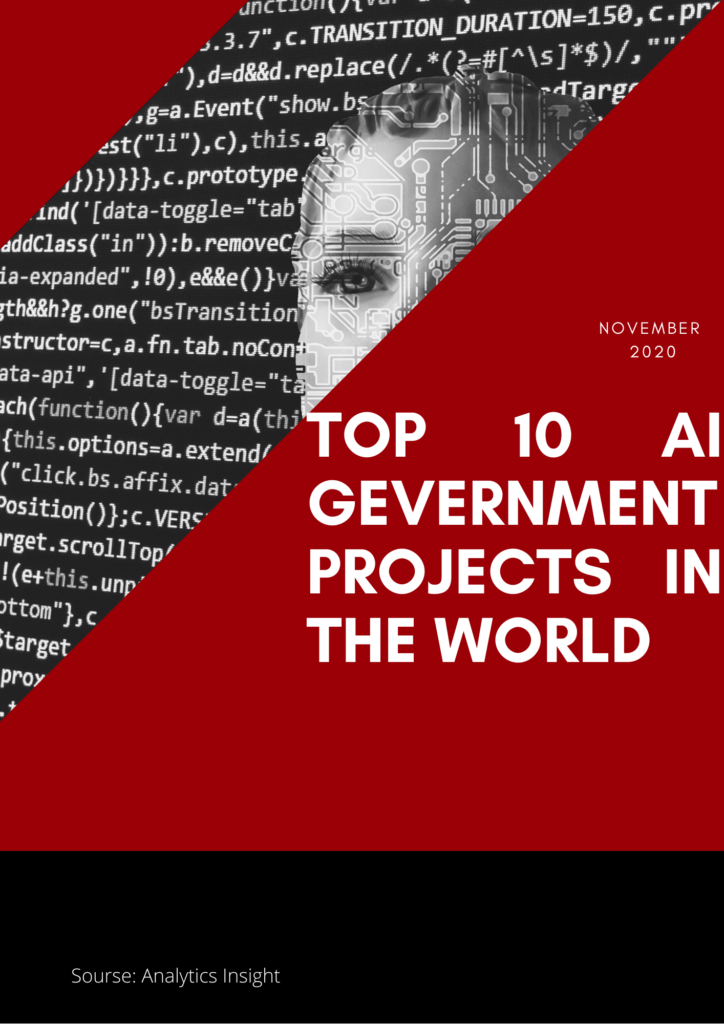The role of different governments of the world in the field of AI
Government enthusiasm for AI has picked up recently, and numerous government authorities are beginning to pose similar inquiries business chiefs were asking a few years back. Governments and huge NGOs are beginning to put resources into AI, spending budget and time on pilot programs for different AI applications and conversations with individuals in the field on the future implications of the innovation.
As machine learning capacities improve, world governments will probably put significantly more in AI research. IDC assessed the US government’s investment in cognitive and artificial intelligence technologies will grow at a CAGR of 54.3% between 2018-2021. Presently, national and local governments are working with the scholarly world and industry pioneers to rejuvenate AI projects that range in application from organizing traffic to digitizing backlogs of government documents.
Let’s look at some of the best AI government projects as well as related policies and activities that have been reported since the release of the initial strategies.
US Citizenship and Immigration Services
In 2015, the US Citizenship and Immigration Services (USCIS) reported the launch of a chatbot named Emma. Emma can apparently address questions on migration and take guests to the correct page of the USCIS site. The USCIS was receiving a high volume of customer questions, with more than 14 million calls on immigration problems every year.
Users can tap the “Ask a Question” and “Need Help? Ask Emma” links in the upper right corner of the USCIS site page. In situations where Emma can’t locate the correct data, the software automatically diverts the user to a human agent.
The chatbot utilizes natural language processing and natural language generation. The algorithm behind the chatbot was likely fed thousands of instant messages including different normal migration questions and requests for services, for example, requests for the status of one’s visa applications.
Canada’s AI Investment in Research and Talent
Canada was the first nation to deliver a national AI strategy. Itemized in the 2017 federal budget, the Pan-Canadian Artificial Intelligence Strategy is a five-year, C$125 million intend to put resources into AI research and talent. The strategy has four objectives: (1) increment the number of AI researchers and graduates, (2) build up to three clusters of scientific excellence, (3) create thought leadership on the economic, ethical, policy, and legal implications of AI, and (4) uphold the national research community on AI.
The Canadian Institute for Advanced Research drives the procedure in close association with the Canadian government and the three new AI Institutes: the Alberta Machine Intelligence Institute (AMII) in Edmonton, the Vector Institute in Toronto, and MILA in Montreal.
The CIFAR AI and Society Program inspects the policy and ethical implications of AI, however, the overall strategy does exclude policies found in different strategies, for example, investments in key areas, data and privacy, or skills development.
Infocomm Development Authority of Singapore
The government of Singapore recently declared a partnership with Microsoft to create conversational interfaces for its Smart Nation Initiative. Vivian Balakrishnan, Minister for Foreign Affairs and head of the Smart Nation Initiative, reported the government’s plans to assess the utilization of chatbots for specific public services. To this end, the Infocomm Development Authority of Singapore (IDA) is working closely with Microsoft to incorporate conversational intelligence into existing public services as a proof of concept project. The objective of the project is to unveil online public service websites more available and connecting with all residents.
Microsoft will likewise work with the government of Singapore to open a Center of Excellence (CoE) for Leadership in Digital Transformation for Government and Industry. The CoE will likewise uphold the proof of concept with IDA to create capacities that can serve multilingual populations and people of varying age.
Denmark’s Digital Growth
Denmark’s Strategy for Denmark’s Digital Growth, launched January 2018, expects to make Denmark a pioneer in the digital revolution and to make development and wealth for every single Danish individual. Instead of concentrating only on advances in AI, the strategy focuses on AI, big data, and the Internet of Things. The strategy has three objectives: (1) make Danish organizations the best at utilizing digital innovations; (2) have the best conditions set up for the digital transformation of business; and (3) guarantee each Dane is furnished with the important digital skills to compete. A pool of DKK 75 million has been assigned in 2018, trailed by DKK 125 million every year until 2025, and DKK 75 million in perpetuity for the usage of the strategy’s initiatives
Atlanta Fire Rescue Department
Artificial intelligence scientists from Georgia Institute of Technology, Emory University, and the University of California, Irvine worked with the Atlanta Fire Rescue Department (AFRD) to build up a predictive analytics software pointed toward recognizing buildings that have a higher likelihood of fire incidents.
The analysts created Firebird, which purportedly utilizes historical data for 58 variables made available to them by the AFRD. This incorporates information, for example, property area, fire incidence, building size, building structure, and year worked for the period 2010–2014. The information was fed to an AI predictive analytics software and the algorithms were changed to forecast fire risk scores for 5,000 buildings. As indicated by the university, the product precisely anticipated 73% of fire incidents in the structure.
China’s Next Generation Artificial Intelligence Development Plan
China reported its desire to lead the world in AI theories, advances, and applications in its July 2017 plan, A Next Generation Artificial Intelligence Development Plan. The plan is the most comprehensive of all national AI strategies, with activities and objectives for R&D, industrialization, talent development, education and skills acquisition, standard setting and regulations, ethical norms, and security.
It is best perceived as a three-stage plan: first, make China’s AI industry “in-line” with contenders by 2020; second, reach “world-leading” in some AI fields by 2025; and third, become the “essential” community for AI development by 2030. By 2030, the government intends to develop an AI industry worth 1 trillion RMB, with related ventures worth 10 trillion RMB.
The arrangement likewise spreads out the government’s goal to enroll the world’s best AI talent, fortify the training of the domestic AI labour force, and lead the world in law, guidelines, and moral standards that advance the improvement of AI. The latter includes the goal to effectively take an interest in and lead the worldwide governance of AI.
City of Pittsburgh Traffic Improvement
The City of Pittsburgh collaborated with Rapid Flow Technologies to create SURTRAC (Scalable Urban Traffic Control), an automated traffic optimization and control software. City traffic control divisions can utilize SURTRAC to oversee traffic flows through a few crossing points and use AI to advance the traffic systems toward diminished travel times, decreased number of traffic stops, and decreased stand by times.
Pittsburgh Department of Transportation worked with Rapid Flow Technologies in 2012 to introduce the system in a pilot project in the East Liberty neighborhood of Pittsburgh. Surtrac was connected to a network of nine traffic signals in three significant roads in Pittsburgh (Penn Circle, Penn Avenue, and Highland Avenue).
India
India has adopted a special strategy to its national AI strategy by concentrating on how India can use AI for economic growth, yet additionally for social incorporation. NITI Aayog, the government think tank that composed the report, calls this methodology #AIforAll. The methodology, therefore, means to (1) upgrade and enable Indians with the abilities to secure quality jobs; (2) put resources into research and sectors that can augment economic growth and social impact; and (3) scale Indian-made AI solutions for the rest of the developing world. Furthermore, the Indian government’s Commerce and Industry Department likewise released a Task Force on Artificial Intelligence for India’s Economic Transformation in 2017.
Singapore Defence
Singapore’s Armed Forces (SAF) is investigating artificially intelligent unmanned systems to battle alongside its warriors, pre-empting its labor deficiency. “The SAF is required to confront a decrease in the number of national servicemen, given Singapore’s low birth rate”, said Ng Chee Khern, Permanent Secretary of Defense Development, Ministry of Defense.
The administration is additionally hoping to improve order, control and communication systems with sensors and cameras, beefing up agency coordination in counter-terrorism operations.
The United States Department of Defense is doing likewise, burning through billions of dollars to create autonomous weapons. The team is researching intelligent fighter jets that can distinguish adversaries on the ground, and has tried smart missiles and autonomous ships that can hunt for enemy submarines.
New York City Department of Social Services
The New York City Department of Social Services (DSS) has a staff of around 18,000 and offers public help and employment services to more than 3,000,000 residents. In one of their initiatives, called the Supplemental Nutrition Assistance Program (SNAP), employees of the government agency expected to process around 70,000 SNAP applications for each month.
Citizens wishing to avail the DSS services were to a great extent strolling into the government’s brick and mortar service centers to present their SNAP applications. With such countless applications and restricted manual assets, DSS chose to digitize and automate the process by offering a self-service online portal called the ACCESS HRA (AHRA).
A definitive objective of the project was to improve the online experience for site guests and diminish the number of individuals entering their brick and mortar service centers. The AHRA gateway purportedly permits users asking about handicap benefits, income support, food assistance, and health insurance to view their case status, account balances, and e-notices.
Conclusion
The race to become a global leader in the space of Artificial Intelligence has already begun. With countries developing unique AI strategies, we will see more government developments in the space of AI.




Asking questions are in fact pleasant thing if you are not understanding something entirely, but this piece of writing provides nice understanding yet.